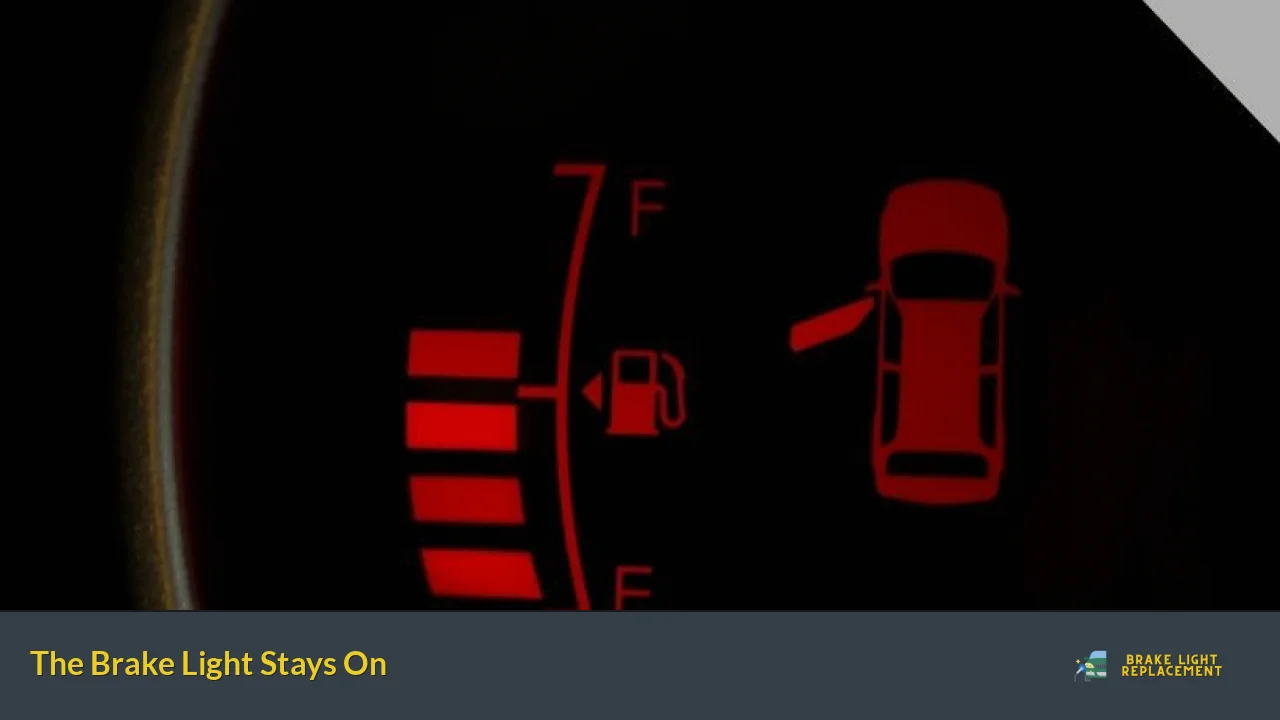Are you frustrated by a brake light that refuses to turn off? It can be quite perplexing and even concerning when your brake light remains illuminated. But fear not, for in this article, we will delve into the reasons why your brake light might be staying on and discuss possible solutions to rectify the issue.
One common culprit for a persistent brake light is a faulty brake switch. This small but vital component, usually located near the brake pedal, sends a signal to illuminate the brake light when you press the brake pedal. If the switch becomes misaligned or malfunctions, it can cause the brake light to stay on continuously. Fortunately, replacing a brake switch is often a straightforward task and can be done without much hassle.
Another potential cause could be low brake fluid levels. When the brake fluid drops below a certain threshold, it triggers a warning system that activates the brake light. Checking your brake fluid reservoir and topping it up if necessary might solve the problem. However, keep in mind that low brake fluid levels could indicate a leak in the braking system, which requires immediate attention from a professional mechanic.
Worn-out brake pads could also be to blame. As brake pads wear down over time, the distance between the pad and the rotor decreases. This reduction in space can trigger the brake light to stay on as a safety precaution. Inspecting your brake pads and replacing them if they are excessively worn is crucial for maintaining optimal braking performance.
Furthermore, a malfunctioning anti-lock braking system (ABS) can be responsible for the persistent brake light. The ABS plays a crucial role in preventing wheel lock-up during sudden stops or slippery conditions. If the ABS encounters a fault, it may activate the brake light to alert you of the issue. Diagnosing and repairing an ABS problem often requires specialized equipment and expertise, so it’s best to seek professional assistance.
A brake light that stays on can stem from various causes such as a faulty brake switch, low brake fluid levels, worn-out brake pads, or a malfunctioning ABS. By identifying the underlying issue and taking appropriate action, you can ensure your vehicle’s safety and restore peace of mind during your journeys on the road. Remember, if you’re unsure about any aspect of diagnosing or fixing the problem, it’s always wise to consult with a qualified mechanic for expert advice.
Automotive Mystery Solved: The Hidden Culprit Behind the Persistent Brake Light On Issue


Introduction:
Have you ever experienced the frustration of a persistent brake light on your car’s dashboard? You’ve double-checked everything, yet that stubborn warning light just won’t turn off. It’s a puzzling situation that many drivers face, but fear not! In this article, we unravel the mystery behind this automotive conundrum and reveal the hidden culprit responsible for the persistent brake light on issue.
The Brake Fluid Level:
One common cause of the persistent brake light on problem is an inadequate brake fluid level. Your vehicle’s braking system relies on hydraulic pressure to function effectively, and if the brake fluid is low, it can trigger the warning light. So, how does this happen? Over time, as the brake pads wear down, the brake fluid level gradually decreases. Additionally, a leak in the brake system can also lead to a drop in fluid levels. Consequently, the brake light remains illuminated until the issue is resolved. Just like your car needs oil to run smoothly, it requires sufficient brake fluid for optimal braking performance.
Faulty Brake Light Switch:
Another sneaky culprit responsible for the persistent brake light on issue is a faulty brake light switch. This small component, usually located near the top of the brake pedal, sends a signal to illuminate the brake lights when the pedal is pressed. However, if the switch malfunctions, it may fail to communicate with the brake lights properly, causing the warning light to stay lit. It’s as if the switch has gone rogue, keeping the brake lights engaged even when you’re not braking. Thankfully, replacing the faulty switch is relatively straightforward and should resolve the issue.
Electrical Problems:
Sometimes, the root cause of the persistent brake light on problem lies in electrical gremlins lurking within your vehicle’s wiring system. Frayed or damaged wires, loose connections, or a malfunctioning control module can all disrupt the proper functioning of the brake light circuit. Identifying and rectifying these electrical issues may require the expertise of a qualified technician equipped with specialized diagnostic tools. These professionals can diagnose and resolve the underlying electrical problem, ensuring that your brake light functions as intended.
In conclusion:
The persistent brake light on issue can be a vexing problem for any driver. However, armed with the knowledge of potential culprits behind this mystery, you can now take appropriate action to resolve it. Whether it’s checking your brake fluid level, replacing a faulty brake light switch, or addressing electrical problems, remember to prioritize safety and consult a professional if needed. Don’t let the persistent brake light on issue keep you in the dark—shine a light on this mystery and drive with confidence once again.
Breaking News: New Study Reveals Surprising Reasons Why Your Brake Light Stays On
Have you ever experienced the frustration of having your brake light stay on, even when you’re not applying the brakes? It’s a perplexing issue that many drivers have encountered at one point or another. Well, get ready to be amazed because a groundbreaking study has unveiled some unexpected reasons behind this common problem.
One surprising cause discovered by researchers is a faulty brake light switch. This small but critical component, located near the brake pedal, can malfunction and cause the brake light to remain illuminated. When the switch fails to detect that the brake pedal is released, it keeps the circuit closed, leaving the light on. This is an issue that needs immediate attention as it can lead to drained batteries and potential accidents.
Another reason for the persistent brake light could be a low level of brake fluid. The study found that when the brake fluid drops below the recommended level, it triggers a sensor in the braking system that activates the brake light. This serves as a crucial safety feature, alerting drivers to check their brake fluid levels promptly. If ignored, it could result in compromised braking performance, putting you at risk on the road.

Furthermore, a worn-out brake pad could be an unexpected culprit. As brake pads wear down over time, a metal indicator built into them comes into contact with the rotor, creating a squealing noise and causing the brake light to activate. This signifies that it’s time to replace your brake pads to maintain optimal braking efficiency and avoid potential damage to other components.
It’s important to note that these findings highlight the significance of regular maintenance and inspections of your vehicle’s braking system. Being proactive about addressing these issues will not only ensure your safety but also save you from costly repairs down the line.
The recent study has shed light on the surprising reasons why your brake light stays on. From a malfunctioning brake light switch to low brake fluid and worn-out brake pads, understanding these causes is crucial for maintaining road safety. Remember to address any brake-related concerns promptly and regularly maintain your vehicle’s braking system to keep yourself and others safe on the road.
Drivers Beware: The Troubling Increase in Brake Light Malfunctions and What It Means for Road Safety
Introduction:
Have you ever been driving down the road, only to suddenly notice that the car in front of you is braking without any warning? It’s a heart-stopping moment that can lead to dangerous situations on the road. Unfortunately, brake light malfunctions have become increasingly common in recent years, posing a significant threat to road safety. In this article, we will delve into the details of this concerning issue and its implications for drivers like you.
The Alarming Surge in Brake Light Malfunctions:
Picture this: you’re driving during rush hour, and the traffic is heavy. You rely on the brake lights of the vehicles ahead to anticipate their movements and react accordingly. However, a growing number of drivers are encountering malfunctioning brake lights, leaving you completely unaware of their intentions. This sudden lack of communication between drivers significantly increases the risk of rear-end collisions and other accidents on the road.
Causes of Brake Light Malfunctions:
Various factors contribute to the rising prevalence of brake light malfunctions. One key factor is age; as vehicles get older, their electrical systems can deteriorate, leading to faulty brake lights. Additionally, poor maintenance practices, such as neglecting to replace worn-out bulbs or faulty wiring, can exacerbate the problem. Furthermore, accidents or minor collisions can also damage the wiring connected to the brake lights, rendering them ineffective.
The Implications for Road Safety:
The consequences of brake light malfunctions go far beyond mere inconvenience. Without functioning brake lights, drivers behind you are unable to gauge your deceleration, resulting in a higher likelihood of rear-end collisions. Pedestrians and cyclists are also at risk, as they depend on brake lights to anticipate when a vehicle is slowing down or stopping. Moreover, the lack of proper signaling compromises the flow of traffic and can lead to confusion and frustration among other drivers, potentially causing road rage incidents.
Taking Action:
To address this growing problem, it is crucial for drivers to be proactive. Regular vehicle maintenance and inspections are essential. Routinely checking brake lights, replacing defective bulbs, and addressing any wiring issues can help prevent malfunctions. Additionally, if you notice a vehicle with malfunctioning brake lights, maintain a safe distance and exercise caution until it is safe to pass or overtake.
Conclusion:
The troubling increase in brake light malfunctions poses a significant threat to road safety. Drivers must remain vigilant and take action to ensure their vehicles’ brake lights are functioning correctly. By prioritizing regular maintenance and promptly addressing any issues, we can work together to mitigate this problem and make our roads safer for everyone. Stay aware, stay safe!
Exclusive Interview with Expert Mechanic: Unveiling the Top Causes of the Infamous ‘Brake Light Stays On’ Dilemma
Are you tired of that stubborn brake light on your dashboard, constantly illuminating and causing you concern? We’ve got you covered! In this exclusive interview with an expert mechanic, we dive deep into the top causes behind the infamous “brake light stays on” dilemma. Prepare to be amazed as we unveil the mysteries lurking beneath your vehicle’s braking system.
One of the most common culprits behind this issue is a simple case of forgetfulness. Yes, it happens even to the best of us! Sometimes, the parking brake might have been engaged without you realizing it. So before panicking, double-check if you’ve accidentally left the parking brake on.
Moving on, another potential culprit lies within the brake fluid reservoir. If the fluid level is low, your brake light could be sending out distress signals. Low fluid levels are often indicative of a leak in the system or worn-out brake pads. It’s crucial to address these issues promptly to ensure your safety on the road.
Next up, let’s talk about the brake switch. This tiny yet mighty component is responsible for detecting when you press the brake pedal. Over time, it can wear out or become misaligned, resulting in a faulty brake light. Fortunately, replacing the brake switch is usually a relatively simple fix for a skilled mechanic.
Moreover, modern vehicles rely on complex electronic systems, and sometimes a glitch in the system can trigger the brake light to stay on. This could be due to a malfunctioning sensor or a software issue. Diagnosing these electrical gremlins requires specialized equipment and expertise, so it’s best to leave it to the professionals.
Lastly, don’t overlook the possibility of a faulty wiring connection. Wires can become damaged or loose, disrupting the communication between various components in the braking system. An experienced mechanic will meticulously inspect the wiring harness to identify any faults and rectify them accordingly.
The “brake light stays on” dilemma can have several underlying causes. From forgetting to release the parking brake to more complex issues with the brake fluid, switch, electrical system, or wiring connections, it’s essential to address these problems promptly to ensure your safety on the road. Remember, when in doubt, consult a trusted mechanic who can expertly diagnose and resolve the issue. Drive safe!
